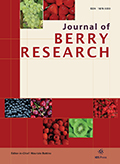Authors: Noriega, Felipe | Mardones, Claudia | Fischer, Susana | García-Viguera, Cristina | Moreno, Diego A. | López, María Dolores
Article Type:
Research Article
Abstract:
BACKGROUND: The native Chilean white strawberry (Fragaria chiloensis ssp. chiloensis f. chiloensis ) is a semi-domesticated crop that has a characteristic aroma and flavor and a low production in southern Chile. However, edaphoclimatic conditions can influence on fruit quality attributes and its health benefits. Establishing a link between seasonal changes and aroma or biological activity require detailed research in exploring bioactive compounds. OBJECTIVE: The present work assessed how seasonal and local changes varied the content of bioactive compounds and therefore change their aromatic quality and the response of biological activity. METHODS: White Strawberry from
…two seasons and two locations were investigated; FCC1, FCC2 (Fragaria chiloensis from Contulmo, 2017 and 2018 season, respectively), FCP1, FCP2 (F. chiloensis from Purén, 2017 and 2018 season, respectively). Measurement of changes on volatile compounds were studied by SPME/GC-MS. Analyses of variations on phenolic compounds were investigated by HPLC-DAD-ESI-MSn with total polyphenolic content and antioxidant capacity by using DPPH• and ORAC assays by spectrophotometric and fluorimetric methods. The relationship between different concentrations of compounds and in vitro biological activity including inhibitory tests for α -glucosidase and acetylcholinesterase were analyzed. RESULTS: In the fruit extracts, 38 volatiles and 27 phenolic compounds were identified detecting differences among the samples, being affected by climatic conditions and location. The total content of ellagic acid and its derivatives was 6.54 mg 100 g–1 FW for FCC1, showing statistical differences with respect to the rest strawberries. Nonetheless, the antioxidant capacity tests revealed high antioxidant capacity for all samples, being FCP2 the significantly highest activity (3314μ mol Trolox 100 g–1 FW by DPPH• assay) compared to the rest of locations and seasons. Additional inhibitory tests α -glucosidase and acetylcholinesterase showed statistically differences due to seasonal and location changes where was observed higher ellagic acid derivates content and bioactivity. The Chilean white strawberry extracts were effective inhibitors of α -glucosidase (non-competitive) and acetylcholinesterase (competitive) activities, respectively, presenting FCC1 the most potent inhibitory effects. CONCLUSIONS: A higher ellagic acid content in Chilean white strawberry, affected by seasonal and location changes, influenced on the biological activity potential. Therefore, the relatively high antioxidant capacity, phytochemical composition and biological activity potential, of these aromatic fruits, offer a great opportunity for the rural developments, however it will be necessary to implement good practices that would guarantee batch-to-batch replicability for quality and composition of these foods for the future.
Show more
Keywords: Agroclimatic conditions, Fragaria chiloensis
, volatiles, acetylcholinesterase, α-glucosidase
DOI: 10.3233/JBR-200585
Citation: Journal of Berry Research,
vol. 11, no. 1, pp. 103-118, 2021





